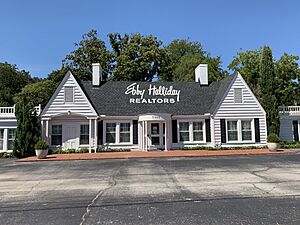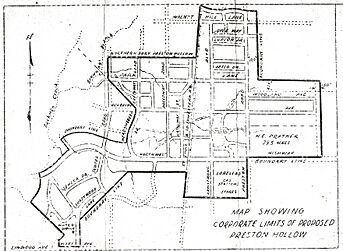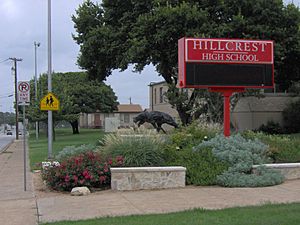Preston Hollow, Dallas facts for kids
Quick facts for kids
Preston Hollow
|
|
|---|---|
|
A house in Preston Hollow 12/22/2024
|
|
| Country | |
| State | |
| County | |
| City | |
| Area | North Dallas |
| ZIP Codes |
75220, 75225, 75230
|
| Area codes | 214, 469, 972 |
Preston Hollow is a neighborhood in North Dallas, Texas. It is located north of Downtown Dallas. This area is known for its large homes and beautiful streets.
Contents
History of Preston Hollow
Preston Hollow started as farmland in the 1850s. Families like the Lively, Howell, and Meaders families received land grants here. There were also smaller farms, including a dairy farm.
Early Homes and Development
The first people moved to Preston Hollow to live there in the 1920s. Ralph Stichter bought a lot of land and built two large homes in 1922. One of these homes, at 6126 Lakehurst, is still standing today.
In 1924, a real estate developer named Ira P. DeLoache bought a 56-acre farm. He divided this land into the first building lots for Preston Hollow. DeLoache and Al Joyce worked together to develop the area, mostly in the 1930s. A famous architect, Charles Dilbeck, designed many grand homes here.
At first, Preston Road was the only way to get to Downtown Dallas. Other roads, like the Northwest Highway, were just muddy paths. The area that is now Preston Center used to be a dairy farm.
Growing as a Community
Developers wanted Preston Hollow to be a special place, not just another suburb. Doctors, business owners, and oil industry people moved there. Many built large country-style homes with space for horses. A private school, which later became St. Mark's School of Texas, also opened in the area.
In the 1930s, during the Great Depression, Edward James Solon bought land in Preston Hollow. A Dilbeck-designed house was built for him. This house was seen as the start of many large estates in what is now called the Old Preston Hollow area. Moving north of Northwest Highway was once thought to be risky for attracting wealthy homeowners. However, E.J. Solon's estate helped start the trend of people moving to North Dallas.
Preston Hollow became its own town in 1939. DeLoache’s real estate office even became the town hall. The town was named for the dark, wooded area with creeks and hollows that stretched west from Preston Road.
Joining Dallas
In 1945, the people of Preston Hollow voted to join the city of Dallas. This happened shortly after. That same year, the nearby towns of University Park and Highland Park (together known as the Park Cities) voted to stay independent.
A book called Preston Hollow: A Brief History tells the story of the neighborhood from the 1850s to a tornado in 2019. There's also a Facebook group called “Preston Hollow History” where people share more information.
In the 1950s, some properties in Preston Hollow had rules that only white residents could live there. These rules were removed in 2000, making the area open to everyone.
Over time, as land became more valuable in the 1980s, many older ranch-style houses were replaced with newer, larger homes.
Who Lives in Preston Hollow?
Preston Hollow is home to many well-known people.
Leaders and Business People
- Former U.S. President George W. Bush lives here.
- Former Dallas mayors Tom Leppert and Laura Miller have also lived in Preston Hollow.
- Important business leaders like the late Ross Perot and the late T. Boone Pickens lived here.
- Other business figures include former American Airlines chairman Bob Crandall and software developer Larry Lacerte.
Sports and Entertainment Stars
- Dallas Mavericks owner Mark Cuban lives in Preston Hollow.
- Famous basketball players like Dirk Nowitzki and Luka Dončić have homes here.
- Former Dallas Cowboys football players such as Roger Staubach, Daryl Johnston, and Chuck Howley have lived in the neighborhood.
- Golfers Lee Trevino and Jordan Spieth are also residents.
Preston Hollow's Layout
Preston Hollow is about 6 miles (10 km) north of Downtown Dallas. Preston Road is the main road that goes through the area. This part of Preston Road is sometimes called the "golden corridor" because of the wealth in the area.
The exact borders of Preston Hollow can be a bit confusing. Generally, it's thought to be bordered by Northwest Highway to the south, Royal Lane to the north, and Hillcrest Road to the east. Some people also include Midway Road as a western border. Real estate agents often use the name "Preston Hollow" broadly because it sounds fancy. The neighborhood is actually made up of several smaller areas.
Areas within Preston Hollow
The original area of the former Preston Hollow town is now called the "Estate area." This part of the neighborhood is known for its very large lots, grand entrances, and winding streets. It has some of the most luxurious mansions in Dallas.
The eastern and northern parts of Preston Hollow have a mix of older and newer homes. Many of the original homes were two stories, but there are also many ranch-style houses from the 1930s, 1940s, and 1950s. Newer homes are much larger, often over 6,000 square feet (557 square meters). Because of these new, bigger houses, the value of the land has gone up a lot.
Economy and Shopping
Preston Center is a commercial area very close to Preston Hollow. It has office towers and businesses.
For shopping, residents can visit the Dallas Galleria and the NorthPark Center, which are both nearby.
Education in Preston Hollow
Preston Hollow has both public and private schools for children.
Public Schools
The Dallas Independent School District (DISD) runs the public schools in the area.
- Elementary Schools: John J. Pershing, Preston Hollow, Walnut Hill International Leadership Academy, and Harry C. Withers.
- Middle Schools: Students from Pershing and Preston Hollow go to Benjamin Franklin Middle School. Students from Walnut Hill go to Medrano Junior High School. Students from Withers go to E.D. Walker Middle School.
- High Schools: Students from Franklin Middle go to Hillcrest High School. Students from Medrano go to Thomas Jefferson High School. Students from Walker go to W.T. White High School.
Some schools, like Withers, Walnut Hill, and Walker Middle, offer special Spanish-English dual-language programs.
School History Notes
Walnut Hill School was one of the first schools for Preston Hollow kids, opening in the 1910s. Hillcrest High School opened in 1938, and Preston Hollow Elementary opened in 1945-1946.
In 2006, Preston Hollow Elementary School was in the news because of a court ruling. The ruling said that the school's way of assigning students to classes was not fair.
Private Schools
Many families in Preston Hollow choose to send their children to private schools.
- Catholic Schools: Ursuline Academy of Dallas (girls' high school) is in Preston Hollow. Other nearby Catholic schools include Jesuit College Preparatory School of Dallas (boys' high school), Christ the King Catholic School (K-8), St. Rita Catholic School (K-8), and St. Monica Catholic School (K-8).
- Other Private Schools: St. Mark's School of Texas (boys, grades 1-12) and Preston Hollow Presbyterian School (grades 1-6) are in the area. Other private schools nearby include Episcopal School of Dallas (PreK-12), Hockaday School (girls, PreK-12), Parish Episcopal School (PreK-12), and Good Shepherd Episcopal School (PreK-8).
- Non-Religious Private Schools: The Greenhill School, Lakehill Preparatory School, and Alcuin School are options for parents who prefer schools not connected to a religious group. The Dallas International School also has campuses nearby.
Colleges and Universities
Preston Hollow is part of the Dallas County Community College District. Southern Methodist University is also close to the neighborhood.
Public Libraries
The Dallas Public Library has a branch in the Preston Hollow area called the Preston Royal Branch. It opened in 1964 and has a unique arched roof.
Parks and Recreation
The City of Dallas has two parks in Preston Hollow: Netherland Park and Preston Hollow Park.
- Preston Hollow Park is about 7.2 acres (2.9 hectares). It has baseball/softball fields, a soccer/football field, tennis courts, a playground, picnic tables, and trails.
- Netherland Park is about 5.3 acres (2.1 hectares) and has tennis courts and trails.
Two homeowner associations in eastern Preston Hollow, Preston Hollow East and Preston Hollow North, also organize fun activities like book clubs and chess games for residents.
Media
The Dallas Morning News is the main newspaper for Dallas. There is also a local newspaper specifically for Preston Hollow residents.
The book Preston Hollow: A Brief History was written by a resident and shares the neighborhood's story.
|






